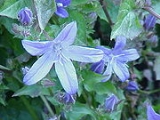
Campanula poscharskyana
Encyclopedia
Campanula poscharskyana, the Serbian Bellflower, is a semi-evergreen
trailing perennial
, valued for its lavender-blue star-shaped flowers, native to the Dinaric Alps
in former Yugoslavia
.
It was first described by Franz Elder von Portenschlag-Ledermayer (1772-1822).
are 2.5-4 cm long. It grows shoots along the ground, about 20-25 cm long, which then turn upward, placing the flowers about 10 cm above ground.
Flowers are lavender-blue and bloom from mid-spring
to early autumn
.
It requires plenty of water, but cannot handle stagnant water, as it asphyxiates the roots. Direct sunlight at noon can make it transpire to death, because it gets too warm. As can strong winds, which dries the plant as well.
The plant is grown in northern Europe, either in flowerbeds in gardens or in flower pots on windowsills, although it prefers gravel or sand, to aerate the roots.
During winter, it survives best at degrees around 5 to 10°C, but can tolerate both colder and warmer temperatures. Although it is considered winter hardy, many growers bring it indoors, and keeps it in just a slightly moist soil on a windowsill or in the basement under a lamp.
It is common to cut the plant down during the fall, to make it conserve energy during winter, and then replant it come spring. During winter, no fertilizer is needed, as the plant does not grow bigger at all.
Plants can be grown from stem cuttings or division of the roots.
The leaves are edible year round, and can be put in salads.
Evergreen
In botany, an evergreen plant is a plant that has leaves in all seasons. This contrasts with deciduous plants, which completely lose their foliage during the winter or dry season.There are many different kinds of evergreen plants, both trees and shrubs...
trailing perennial
Perennial plant
A perennial plant or simply perennial is a plant that lives for more than two years. The term is often used to differentiate a plant from shorter lived annuals and biennials. The term is sometimes misused by commercial gardeners or horticulturalists to describe only herbaceous perennials...
, valued for its lavender-blue star-shaped flowers, native to the Dinaric Alps
Dinaric Alps
The Dinaric Alps or Dinarides form a mountain chain in Southern Europe, spanning areas of Slovenia, Croatia, Bosnia and Herzegovina, Serbia, Kosovo, Albania and Montenegro....
in former Yugoslavia
Yugoslavia
Yugoslavia refers to three political entities that existed successively on the western part of the Balkans during most of the 20th century....
.
It was first described by Franz Elder von Portenschlag-Ledermayer (1772-1822).
Description
LeavesLeaf
A leaf is an organ of a vascular plant, as defined in botanical terms, and in particular in plant morphology. Foliage is a mass noun that refers to leaves as a feature of plants....
are 2.5-4 cm long. It grows shoots along the ground, about 20-25 cm long, which then turn upward, placing the flowers about 10 cm above ground.
Flowers are lavender-blue and bloom from mid-spring
Spring (season)
Spring is one of the four temperate seasons, the transition period between winter and summer. Spring and "springtime" refer to the season, and broadly to ideas of rebirth, renewal and regrowth. The specific definition of the exact timing of "spring" varies according to local climate, cultures and...
to early autumn
Autumn
Autumn is one of the four temperate seasons. Autumn marks the transition from summer into winter usually in September or March when the arrival of night becomes noticeably earlier....
.
Cultivation and uses
It thrives outdoors during summers with short nights, with more light bringing more flowers. Even during winter it survives better with plenty of sunlight. It is fed with fertilizer every second week during summer.It requires plenty of water, but cannot handle stagnant water, as it asphyxiates the roots. Direct sunlight at noon can make it transpire to death, because it gets too warm. As can strong winds, which dries the plant as well.
The plant is grown in northern Europe, either in flowerbeds in gardens or in flower pots on windowsills, although it prefers gravel or sand, to aerate the roots.
During winter, it survives best at degrees around 5 to 10°C, but can tolerate both colder and warmer temperatures. Although it is considered winter hardy, many growers bring it indoors, and keeps it in just a slightly moist soil on a windowsill or in the basement under a lamp.
It is common to cut the plant down during the fall, to make it conserve energy during winter, and then replant it come spring. During winter, no fertilizer is needed, as the plant does not grow bigger at all.
Plants can be grown from stem cuttings or division of the roots.
The leaves are edible year round, and can be put in salads.

